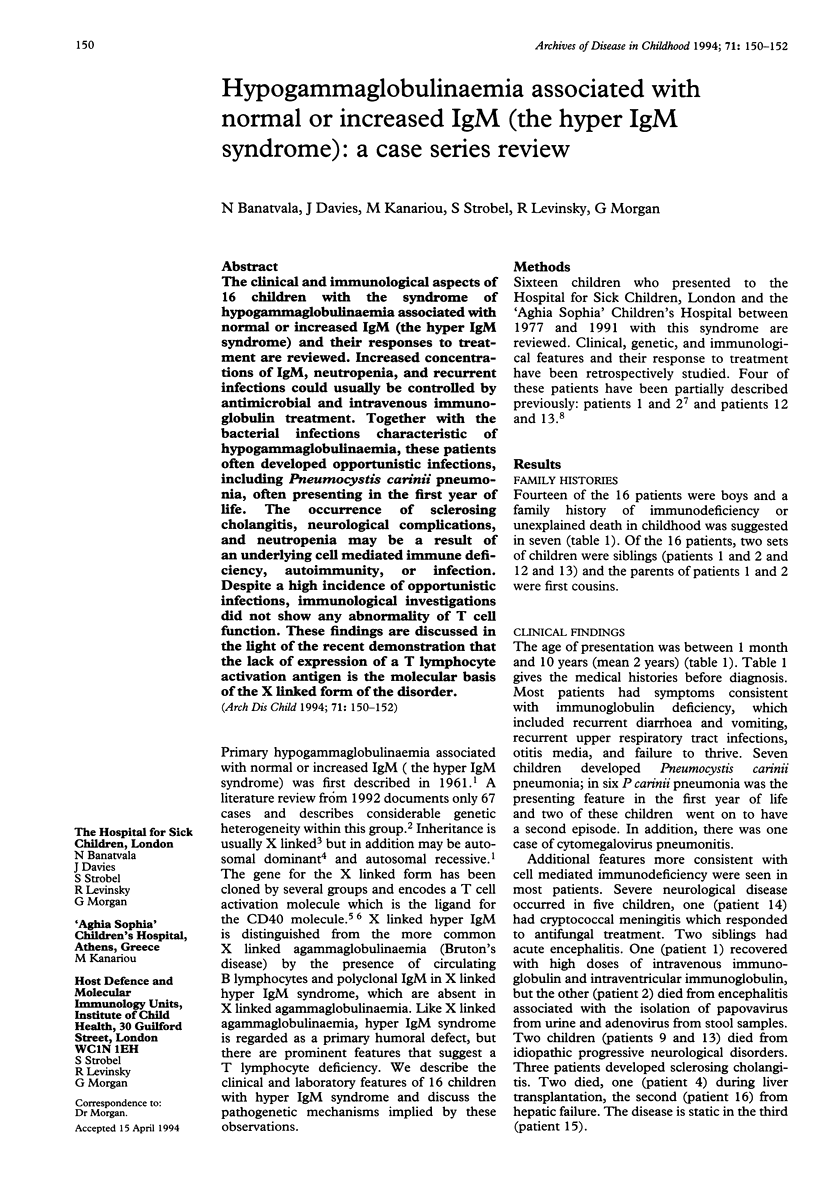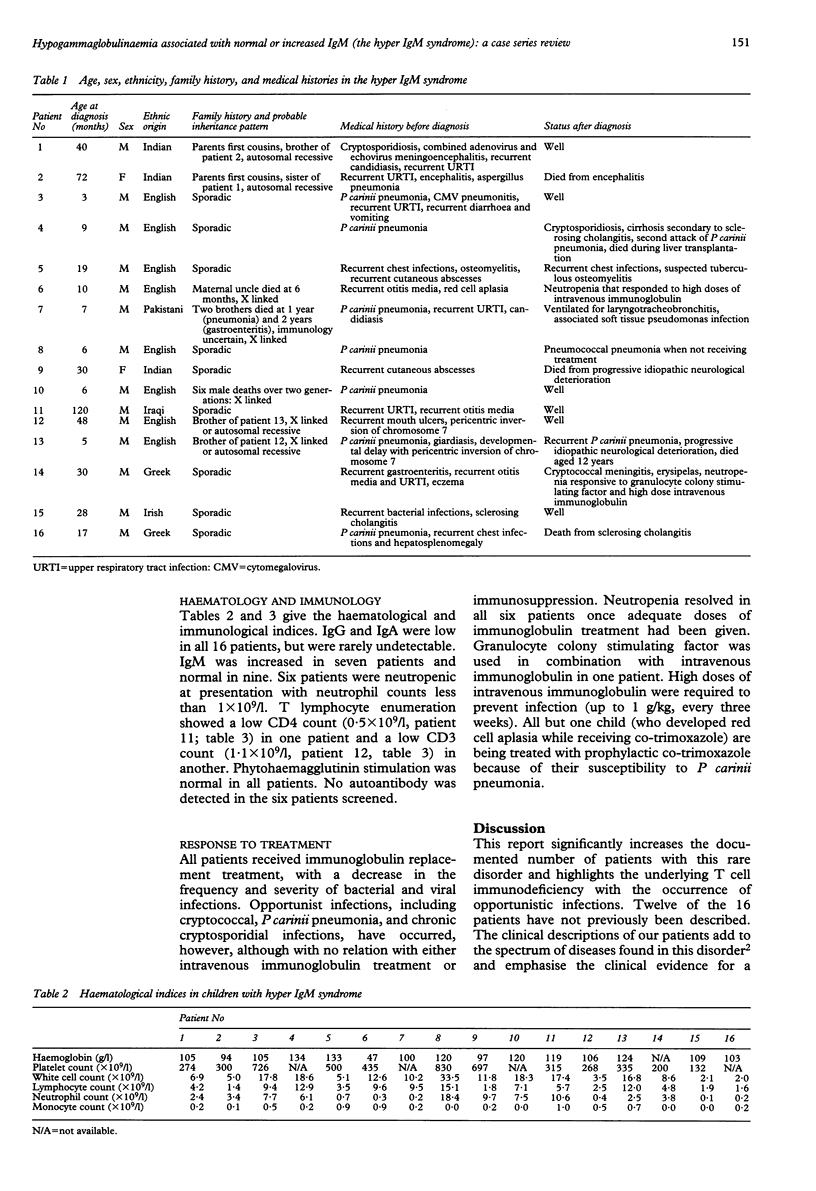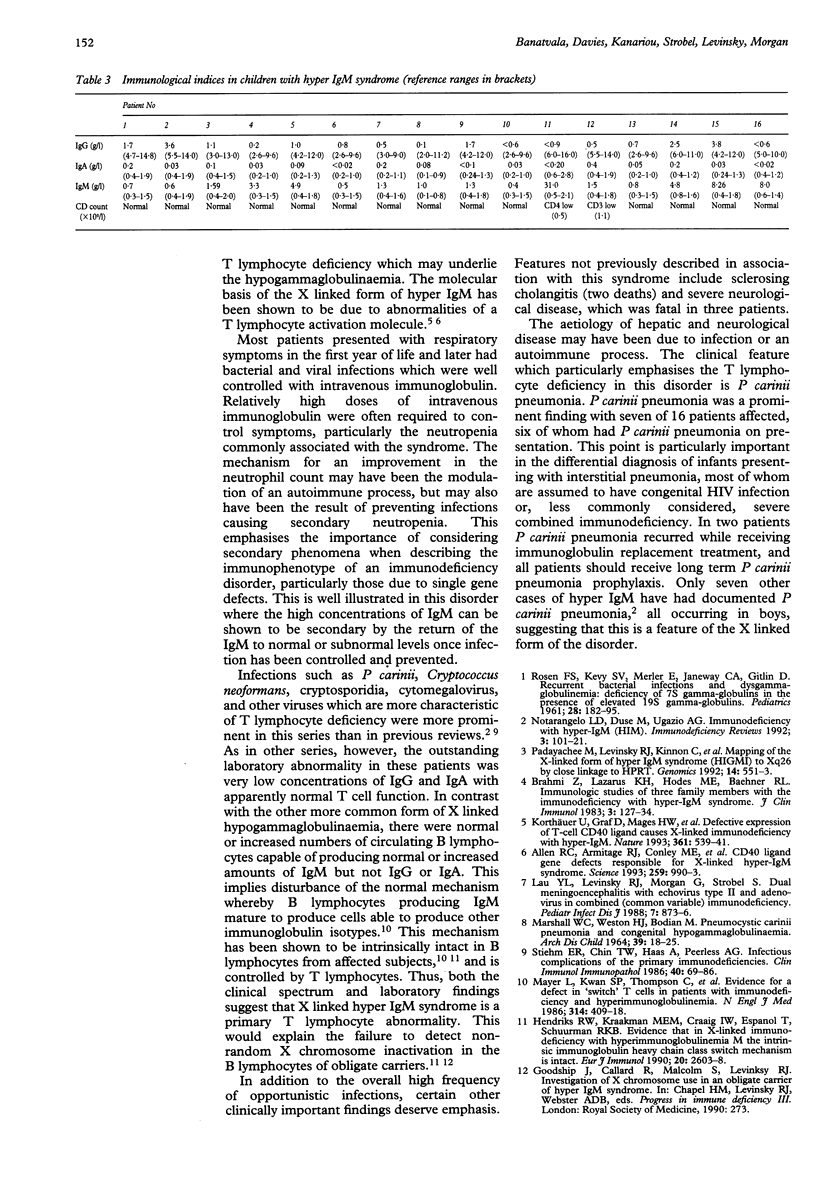Abstract
The clinical and immunological aspects of 16 children with the syndrome of hypogammaglobulinaemia associated with normal or increased IgM (the hyper IgM syndrome) and their responses to treatment are reviewed. Increased concentrations of IgM, neutropenia, and recurrent infections could usually be controlled by antimicrobial and intravenous immunoglobulin treatment. Together with the bacterial infections characteristic of hypogammaglobulinaemia, these patients often developed opportunistic infections, including Pneumocystis carinii pneumonia, often presenting in the first year of life. The occurrence of sclerosing cholangitis, neurological complications, and neutropenia may be a result of an underlying cell mediated immune deficiency, autoimmunity, or infection. Despite a high incidence of opportunistic infections, immunological investigations did not show any abnormality of T cell function. These findings are discussed in the light of the recent demonstration that the lack of expression of a T lymphocyte activation antigen is the molecular basis of the X linked form of the disorder.
Full text
PDF


Selected References
These references are in PubMed. This may not be the complete list of references from this article.
- Allen R. C., Armitage R. J., Conley M. E., Rosenblatt H., Jenkins N. A., Copeland N. G., Bedell M. A., Edelhoff S., Disteche C. M., Simoneaux D. K. CD40 ligand gene defects responsible for X-linked hyper-IgM syndrome. Science. 1993 Feb 12;259(5097):990–993. doi: 10.1126/science.7679801. [DOI] [PubMed] [Google Scholar]
- Brahmi Z., Lazarus K. H., Hodes M. E., Baehner R. L. Immunologic studies of three family members with the immunodeficiency with hyper-IgM syndrome. J Clin Immunol. 1983 Apr;3(2):127–134. doi: 10.1007/BF00915483. [DOI] [PubMed] [Google Scholar]
- Hendriks R. W., Kraakman M. E., Craig I. W., Espanol T., Schuurman R. K. Evidence that in X-linked immunodeficiency with hyperimmunoglobulinemia M the intrinsic immunoglobulin heavy chain class switch mechanism is intact. Eur J Immunol. 1990 Dec;20(12):2603–2608. doi: 10.1002/eji.1830201212. [DOI] [PubMed] [Google Scholar]
- Korthäuer U., Graf D., Mages H. W., Brière F., Padayachee M., Malcolm S., Ugazio A. G., Notarangelo L. D., Levinsky R. J., Kroczek R. A. Defective expression of T-cell CD40 ligand causes X-linked immunodeficiency with hyper-IgM. Nature. 1993 Feb 11;361(6412):539–541. doi: 10.1038/361539a0. [DOI] [PubMed] [Google Scholar]
- Lau Y. L., Levinsky R. J., Morgan G., Strobel S. Dual meningoencephalitis with echovirus type 11 and adenovirus in combined (common variable) immunodeficiency. Pediatr Infect Dis J. 1988 Dec;7(12):873–876. [PubMed] [Google Scholar]
- MARSHALL W. C., WESTON H. J., BODIAN M. PNEUMOCYSTIS CARINII PNEUMONIA AND CONGENITAL HYPOGAMMAGLOBULINAEMIA. Arch Dis Child. 1964 Feb;39:18–25. doi: 10.1136/adc.39.203.18. [DOI] [PMC free article] [PubMed] [Google Scholar]
- Mayer L., Kwan S. P., Thompson C., Ko H. S., Chiorazzi N., Waldmann T., Rosen F. Evidence for a defect in "switch" T cells in patients with immunodeficiency and hyperimmunoglobulinemia M. N Engl J Med. 1986 Feb 13;314(7):409–413. doi: 10.1056/NEJM198602133140703. [DOI] [PubMed] [Google Scholar]
- Notarangelo L. D., Duse M., Ugazio A. G. Immunodeficiency with hyper-IgM (HIM). Immunodefic Rev. 1992;3(2):101–121. [PubMed] [Google Scholar]
- Padayachee M., Feighery C., Finn A., McKeown C., Levinsky R. J., Kinnon C., Malcolm S. Mapping of the X-linked form of hyper-IgM syndrome (HIGM1) to Xq26 by close linkage to HPRT. Genomics. 1992 Oct;14(2):551–553. doi: 10.1016/s0888-7543(05)80270-8. [DOI] [PubMed] [Google Scholar]
- Stiehm E. R., Chin T. W., Haas A., Peerless A. G. Infectious complications of the primary immunodeficiencies. Clin Immunol Immunopathol. 1986 Jul;40(1):69–86. doi: 10.1016/0090-1229(86)90070-x. [DOI] [PubMed] [Google Scholar]


